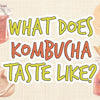Fermented Drinks: 27 Unique And Wonderful Ferments
Fermented drinks have been around since the beginning of human civilization. More recently, though, a culture has developed around fermented drinks, and they're regaining in popularity. Hundreds of variations exist with limitless options for brewing techniques and flavorings. We'll break everything down and into an easy to understand guide, ideal for both fermenting newbies and expert brewers alike.
Not Much Time? Skip To What You'd Like To Learn...
-
What Is A Fermented Drink?
-
Considerations Before Buying A Fermented Drink
-
Health Benefits Of Fermented Drinks
-
Common Questions
-
Types Of Fermentation
-
Fermented Teas & Tonics
-
Fermented Milk Drinks
-
Fermented Alcoholic Drinks
What Is A Fermented Drink?
A fermented drink is a beverage that has undergone the brewing process where its sugars are "eaten" by yeast or bacteria to transform into a fermented drink. This is different from other types of beverages that are flavored and mixed before being bottles. Fermented drinks take time to ferment and develop before they're bottled and sold.
Considerations Before Buying A Fermented Drink

-
Type Of Ferment. There are many ways to ferment a drink. It could be with a SCOBY, culture, or other types of bacteria. If you're unsure of the type of bacteria or yeast used to ferment the food, then do a little bit of research to ensure you're going to benefit.
-
Dietary Requirements. Not all cultures are considered vegetarian, vegan, or lacto-free. This is due to the source of the culture of what is being fermented. If you have specific dietary requirements, make sure they match them.
-
Low Immunity. For those that suffer from deficient immunity, your physician may advise you to avoid all unpasteurized and fermented food. As they contain a lot of good and bad bacteria if you're susceptible to infections, it is not advisable to consume.
-
Pasteurization. Many health professionals would not advise drinking anything that hasn't been pasteurized. The pasteurization process kills all of the bacteria in a drink. Others argue that by pasteurizing your food that you lose the health benefits. This process is something to be aware of.
-
Underlying Health Conditions. If you have diabetes or any other type of health condition, then do some research to see if you can drink fermented beverages. Consider looking for alternatives that meet your requirements. Somebody who has diabetes may be able to drink a low-sugar alternative.
Health Benefits Of Fermented Drinks
The health benefits of kombucha and other fermented drinks have been covered extensively in some of our other articles which you can check out. Below is a short list of 5 benefits claimed to have come from fermented drinks.
1. Immune System. Studies have shown that by drinking or eating probiotics, then it can improve your immune system.
2. Gut Health. Bacteria, found in fermented drinks can bring the balance back between microbes and bacteria. When brought back into balance, the health of your gut could be improved. The improved balance will help with digestion.
3. Improved Mood And Behaviour. A study showed that by consuming fermented food, the levels of serotonin, and dopamine increase. These chemicals are responsible for the feeling of happiness.
4. Reduce Inflammation. With its help in aiding gut health and balance in doing so, it's thought that it can also reduce inflammation. Inflammation has been shown to impact chronic disease and many other issues within the body.
5. Weightloss. When the balance of bacteria is out, it's thought to cause sugar craving. When the cravings reduce, it's easier to resist the urge to snack or eat sugary treats. By consuming probiotics, it can aid in weight loss.
As shown with these 5 examples, it all comes back to the influence the probiotics have on the gut. By altering the microbes in the gut, it can improve overall health.
Common Questions

Are Fermented Drinks Alcoholic?
They can be yes. For best practice, check the label if this may be an issue to you. A lot of commercially produced fermented drinks that are sold in grocery stores are classified as non-alcoholic — having an ABV rating of 0.5% or below. Many brewers are producing non-alcoholic drinks so that everyone can consume them.
Average Sugar Content
This can and will vary widely based on the type of drink. You would have to look at your manufacturer's details to get an accurate answer. For example kombucha can commonly be 6-10 grams per 8oz serving.
Types Of Fermentation
There are three main ways that fermentation can happen at a chemical level. The factors include the fuel (sugar, fructose, starch or other glucose sources) and the yeast or bacteria that is breaking them down. Depending on the combination, the outcome will vary, producing very different tasting beverages.
Lactic Acid Fermentation
This process uses yeast and bacteria to produce lactic acid. The yeast and bacteria feed on the sugar during the ferment, thus converting sugar into lactic acid. Lactose in milk is sugar. This sugar is used in milk based ferments to fuel the lactic acid ferment to produce drinks such as kefir or cottage cheese.
Alcohol Fermentation
Popular drinks such as beer and wine are produced using alcohol fermentation. In this process, yeast breaks the sugars down to produce alcohol as the byproduct; the main product produced is ATP.
Acetic Acid Fermentation
Sugars from grains and fruit breakdown to create acetic acid. This produces popular sour condiments such as apple cider vinegar and wine vinegar. This process happens after you've already completed the alcohol fermentation process and then leave your brew to sit and further ferment to produce vinegar.
27 Fermented Drinks

There are many types of fermented drinks with differences in flavor, ingredients, brewing technique, and type of yeast or starter culture. We've split the beverages into three broad categories to try and help you sort through and learn about each type. Fermented Teas & Tonics; Fermented Milk Drinks and Fermented Alcoholic Drinks.
By no means is this an exhaustive list but covers the most common fermented drinks and acts as a good starting point for your fermenting journey.
Fermented Teas & Tonics
Teas, tonic, vegetable, and fermented fruit drinks are often the poster boy for the healthy drink movement. Mostly down to the fact that the ingredients added to the brew are healthy, to begin with. For example, herbal teas, ginger, spices, and vegetables. After the ferment, they also become loaded with probiotic goodness. For this reason, they are trendy in health food stores.
Kombucha - A fermented tea drink, often brewed with green or black teas. This type of fermented beverage has surged in popularity in the last 10 years. It's made by steeping tea bags and then left to ferment with sugar and a SCOBY for 10-14 days.
Water Kefir - Otherwise known as tibiscos is made using water, bacteria, and yeast. This is a non-dairy version of the famous milk kefir. It's also a quick beverage to ferment, typically being ready in 24-48 hours.
Ginger Beer - One of the most popular beverages throughout the world. This is non-alcoholic and has been made using ginger spice, yeast, and sugar. Thinking to have originated in the Carribean, a popular way to serve it is with rum and ice.
Jun - Jun tea is a type of kombucha that has been brewed with honey. Sugar feeds the SCOBY when the kombucha is brewing, however instead of using cane sugar jun tea is made using honey. A delicious, slightly fizzy beverage.
Root Beer - Alcoholic, no-alcoholic, carbonated, uncarbonated, with or without caffeine. This is a versitline fermented drink. The primary consumer of this delicious ferment is the USA. Smooth and sweet with that distinct root taste coming through.
Tepache - A Mexican favorite. Tepache uses pineapple rind and peel to create a sweet tasting fermented tea, often sweetened with sugar. This drink is quick and easy to produce. With large latino communities in the south west region of the USA, you can often pick up a bottle of tepache to try in Mexican themed shops and restaurants.
Tejuino - Another Mexican ferment, tejuino is made from fermented corn. The same type of corn used to ferment the drink is also used in making tortillas and other Mexican bread. The tejuino beverage comes from the Jalisco province in Mexico and is mainly consumed within the province too.
Salgam - Translated Salgam means "turnip juice," this fresh delight comes from Turkey. The red drink is consumed after a meal. The reported effects include aiding digestion, calming, strengthening bones, and teeth, also being good for your cardiovascular system, liver, eyes, and stomach.
Podpiwek - An Eastern European beverage made from the byproducts of brewing beer. This is a very low to non-alcohol drink mostly drank by women and children. It can contain ingredients such as coffee too.
Fermented Milk Drinks

Dairy has come under fire over the past few years for its purported negative impact on health. Despite this fermented milk drinks and yogurt have been used to improve health for thousands of years, with many believing it will make them strong and improve health. Now we're slowly learning about microbiotics and how they may be able to help us with gut health and bacteria.
Fermented milk drinks undergo lactic acid fermentation, so the process usually only takes a maximum of a few days. Some drinks may just fermented for under 12 hours before consuming. If they've been fermented for too long and taste sour, some people will add some of the first liquid into the fermented one to dilute it slightly and bring the taste back to being sweet.
Milk Kefir - This probiotic drink has become very common. Milk becomes fermented, turning sour and carbonated. Kefir grains can be found at local health food stores or online too.
Nut Milk Kefir - A plant based alternative to milk kefir. It's fermented in the same way, but instead of milk uses alternatives such as almond, coconut, cashew, or soy milk. This has become a lot more popular in the last few years due to the rise of plant based diets and gut health.
Yogurt - Although maybe not a drink, it's still worth a mention - it was once enjoyed by ancient civilizations. To make yogurt, you need to ferment milk using certain bacteria. The bacteria cause the fermentation of milk over days, thickening it before you consume it.
Lassi - Known in the west as an Indian milk drink, an icon of the subcontinent. The official definition of lassi: "Lassi is a blend of yogurt, water, spices and sometimes fruit" - Source: Wikipedia. A mixture of ingredients that make the sweet treat can be found on street corners and in restaurants all over India.
Amasi - A South African fermented milk drink that tastes just like yogurt. It is consumed in two main ways, by adding as a porridge topper or just an everyday milk drink.
Amazake - Rice is the main ingredient in this Japanese favorite. Although made from fermented rice Amazake has a milky appearance and taste, turning it into a sweet treat. It has a very low alcohol content and is often consumed within a relaxing home context.
Chal - A fermented camel's milk drink originating in central Asia. It's touted by drinkers to be a miracle health drink that promotes a healthy gut and digestion.
Kumis - Produced with mare's milk kumis is similar in taste to milk kefir. Often now it's commercially made using cow's milk due to the shortage of mares. Mare's milk and cow's milk are different in the fact that they contain different amounts of sugar which effect the ferment.
Fermented Alcoholic Drinks

Probably considered the most unhealthy of all fermented drinks are the alcoholic variety. For when certain drinks are fermented ethanol is released and makes a drink alcoholic. Ethanol on its own, is considered toxic to the human body. When diluted in beverages, alcohol iss enjoyed socially.
Beer - A drink known to have built civilisations, the pyramids and help explorers travel the world. It could be the most drank beverage in the world, after water. Beer is made using hops and then fermented using special bacteria, creating the much loved fresh and fizzy alcoholic drink.
Wine - The grapes are picked before fermenting, and aging begins. The aging process happens before bottling, changing the taste, and influencing the flavors. The french may be famed for the best wine, but you can now source wine from all areas of the world.
Champagne - The crem de le crem of all sparkling and fermented drinks. Infamous for its taste, cost, and extravagance. This French treat is famous around the world for the sweet, light taste with a slight fizz.
Cider - A poular beverage in the UK and Ireland this a fruity alcoholic drink. It is described best as a fruity sweet fizz. Most commonly made from apples however also coming from pears and berries too. Other European countries such as France, Portugal, and Spain have their cider variation too.
Rice Wine - Commonly associated with asian restaurants and a seriously strong brew. Rice wine has been fermented and distilled from rice. Rice is left to ferment before distilled into stronger liquor. Rice wine can be consumed as wine, liquor, added to food or even left to further ferment and as vinegar.
Kvass - Originating in Eastern Europe and Russia this drink comes from fermented bread. Kvass is made traditionally by mixing bread, malt, and water before brining to the boil and left to cool. It will then sit to ferment until the taste is just right.
Bionade - Instead of a unique drink, bionade refers to a range of beverages produced by a drinks company in Germany. Bionade is a fermented non-alcoholic drink that comes in multiple flavors.
Lambanog - Originating in the Philippines, Lambanog comes from coconut or nipa palm trees. The coconut or nipa palm trees are first fermented into palm wine which is then distilled to create the stronger liquor. Notorious for its high alcohol content, beware when trying!
Calpis - A brand of Japanese non-alcoholic soft drink that appears as a milky white color. The ingredients are water and nonfat milk. When consuming, it's often diluting with milk or water.
In Summary
A list of 27 unique fermented beverages for you to try, make or taste. Found from all over the world, fermented beverages have been consumed, brewed, and invented each with a unique taste. One thing is in common, though, they have a unique place in our history and continue to be loved and consumed today more than ever.







